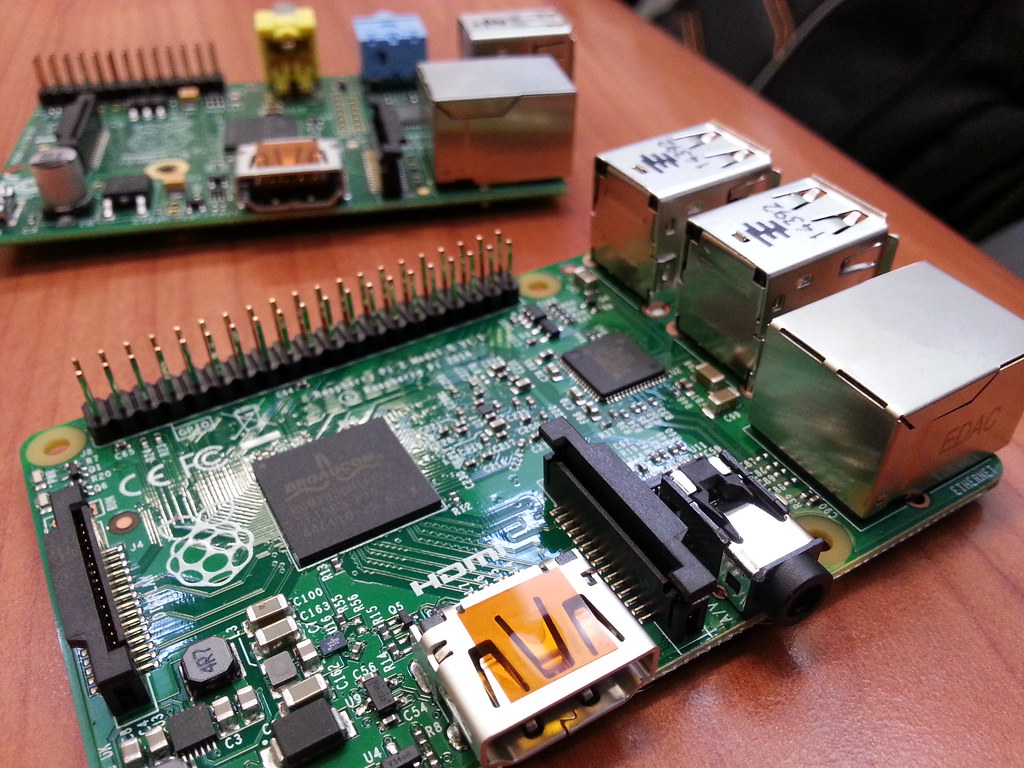The Raspberry Pi has emerged as a cornerstone in modern computing, offering a platform for enthusiasts and professionals to innovate and create. Integrating it with ChatGPT unlocks a new dimension of possibilities, blending the physical computing capabilities of the Pi with advanced natural language processing.
A notable statistic is that while the Raspberry Pi itself cannot run the ChatGPT model, it can interact with an API that allows users to query the AI running in the cloud, bridging the gap between compact computing and powerful AI solutions¹.
I. Introduction
The integration of Raspberry Pi with ChatGPT opens a new frontier in the realm of affordable computing and artificial intelligence. This article delves into the myriad of potential projects that harness the computational power of Raspberry Pi and the sophisticated language processing capabilities of ChatGPT. From educational tools to home automation systems, the synergy of these technologies can revolutionize how we interact with machines and process information.
The Raspberry Pi is a versatile and cost-effective single-board computer that has democratized access to computer science education and innovative projects. On the other hand, ChatGPT, with its natural language processing prowess, offers an intuitive way for humans to communicate with computers. By integrating these two powerful tools, enthusiasts and professionals alike can create projects that were once the domain of high-end computing systems.
In this article, we will explore various applications ranging from simple educational setups to complex business solutions. Each project idea will be examined for its practicality, impact, and scalability. Whether you are a hobbyist looking to experiment or a professional seeking to implement cost-effective solutions, the insights provided here will serve as a valuable guide to the exciting possibilities that lie ahead.
II. Setting Up the Environment
The foundation of any Raspberry Pi and ChatGPT integration project lies in the setup of the environment. This involves assembling the necessary hardware components, such as the Raspberry Pi itself, a power supply, and peripherals like a keyboard, mouse, and display. Additionally, a stable internet connection is crucial for accessing the ChatGPT API and other online resources.
On the software side, the Raspberry Pi should be equipped with the latest version of its operating system, Raspberry Pi OS. Installing Python is also essential, as it is commonly used for scripting interactions with the ChatGPT API. Furthermore, developers must obtain API keys from OpenAI and configure their systems to communicate with ChatGPT effectively.
Testing the setup is a critical step to ensure that all components are functioning correctly. A simple script can be written to send a request to ChatGPT and receive a response. This initial communication verifies that the Raspberry Pi can reach the ChatGPT service and that the API keys are working as intended.
This section of the environment setup is pivotal for the success of subsequent projects. It lays the groundwork for a seamless integration, allowing creators to focus on the innovative aspects of their projects without being hindered by technical issues.
III. Educational Projects
The Raspberry Pi and ChatGPT integration shines in the educational sphere, where it can transform traditional learning methods. One such project is the Interactive Learning Assistant, a tool that leverages ChatGPT’s natural language processing to provide students with a conversational learning experience. This assistant can answer questions, explain concepts, and even administer quizzes, making learning more engaging and personalized.
Another project is the Language Learning Tool, which utilizes ChatGPT’s multilingual capabilities. By interacting with the tool, students can practice speaking, listening, and writing in different languages, with immediate feedback from the AI. This project not only aids in language acquisition but also introduces students to AI technology.
The Programming and Coding Tutor is a project that can revolutionize how coding is taught. With ChatGPT’s ability to understand and generate code, this tutor can offer step-by-step guidance, debug student’s code, and provide challenges to improve their programming skills. This hands-on approach can make learning to code more accessible and less intimidating for beginners.
Each of these projects can be tailored to different educational levels and subjects, making them versatile tools in the classroom. They demonstrate the potential of integrating cutting-edge AI with accessible hardware to enhance the educational experience.
IV. Home Automation Projects
Integrating Raspberry Pi with ChatGPT can significantly enhance home automation projects. A prime example is the Voice-Controlled Smart Home System. Utilizing ChatGPT’s natural language understanding, residents can control lighting, temperature, and security systems through simple voice commands. This project not only adds convenience but also promotes energy efficiency and safety.
Another innovative application is a ChatGPT-Driven Security Enhancement. By integrating ChatGPT with cameras and sensors, the system can provide real-time alerts and insights about home security. It can even simulate occupancy to deter potential intruders, making it a smart addition to any home security setup.
The Energy Management and Optimization project leverages ChatGPT’s ability to process large datasets to analyze energy usage patterns. It can suggest optimizations for reducing energy consumption, leading to cost savings and a reduced carbon footprint. This project demonstrates the potential of AI in making homes more sustainable.
These projects showcase the practical benefits of combining Raspberry Pi’s hardware capabilities with ChatGPT’s advanced language models. They offer a glimpse into a future where homes are not just smart, but also interactive and responsive to their inhabitants’ needs.
V. Entertainment and Media Projects
The fusion of Raspberry Pi and ChatGPT can revolutionize entertainment and media experiences. A project that stands out is the Personalized Media Center with ChatGPT Recommendations. This system uses ChatGPT’s language understanding to suggest movies, music, and TV shows based on the user’s preferences and past interactions. It’s a tailored entertainment hub that learns and grows with the user’s tastes.
Another engaging project is the ChatGPT-Powered Gaming Experience. By integrating ChatGPT into gaming environments, developers can create dynamic storylines and dialogues that respond to player choices. This leads to a more immersive and interactive gaming experience that can adapt to different play styles and decisions.
Creating a ChatGPT-Based Virtual Art Gallery is another innovative application. This gallery can guide visitors through exhibits using natural language, providing information and answering questions about the artwork. It’s an interactive educational experience that brings art to life through conversation.
These projects highlight the potential of combining Raspberry Pi’s hardware flexibility with ChatGPT’s conversational AI to create personalized and interactive media experiences that were previously not possible on such accessible platforms.
VI. Business and Productivity Projects
The Raspberry Pi and ChatGPT duo can be a game-changer for business and productivity. A notable project in this domain is the ChatGPT for Customer Service Automation. This system can handle customer inquiries, provide support, and even manage bookings using natural language processing. It’s a cost-effective solution that can improve customer satisfaction and operational efficiency.
Another project is the Project Management Assistant. By integrating ChatGPT, teams can receive AI-driven insights and recommendations for project planning and execution. This assistant can track progress, remind deadlines, and facilitate communication, making project management more streamlined and less stressful.
The Data Analysis and Reporting Tool is an application that can automatically generate reports by analyzing data sets. With ChatGPT’s language generation capabilities, it can present complex data in an understandable format, making it easier for businesses to make informed decisions.
These projects illustrate the potential of Raspberry Pi and ChatGPT in enhancing business operations, improving productivity, and driving innovation. They offer scalable solutions that can adapt to various business needs and sizes.
VII. Advanced Technical Projects
The combination of Raspberry Pi and ChatGPT can lead to groundbreaking advancements in technical projects. One such project is the ChatGPT-Driven Robotics Interface, which allows hobbyists and researchers to control robotic mechanisms using natural language commands. This interface can simplify complex tasks, making robotics more accessible to a broader audience.
In the realm of machine learning and data science, integrating ChatGPT with Raspberry Pi can facilitate experiments that were previously limited to more powerful machines. For instance, a project could involve using ChatGPT to interpret data from various sensors, enabling predictive analytics and real-time decision-making.
IoT projects stand to gain significantly from this integration. With ChatGPT at the core, a network of interconnected devices can communicate more effectively, automating tasks and providing insights. For example, a Raspberry Pi could serve as the central hub in a smart agricultural system, using ChatGPT to process data and provide recommendations for crop management.
These advanced technical projects highlight the potential of Raspberry Pi and ChatGPT to drive innovation in fields that require a blend of hardware interfacing and sophisticated language processing.
VIII. Community and Social Projects
The Raspberry Pi and ChatGPT integration can also foster community engagement and social innovation. A compelling project in this category is using ChatGPT as a community interaction tool. It can facilitate local forums, organize events, and serve as a platform for community announcements, enhancing the sense of togetherness and participation.
Another project is crowdsourcing information for communal benefit. ChatGPT can analyze and synthesize community-generated data to provide insights on local issues, suggest improvements, and even predict future community needs. This can lead to more informed decision-making and a proactive approach to community development.
Lastly, enhancing accessibility with ChatGPT can make technology more inclusive. By providing voice-to-text and text-to-voice services, or assisting users with different abilities to navigate technology, ChatGPT can help bridge the digital divide and empower all members of society.
These projects underscore the potential of Raspberry Pi and ChatGPT to not only serve individual needs but also to contribute to the welfare and advancement of communities at large.
IX. Challenges and Considerations
When embarking on projects that integrate Raspberry Pi with ChatGPT, it’s crucial to address several challenges and considerations. Privacy and security are paramount, especially when personal data is processed. Implementing robust encryption and user authentication can mitigate risks, ensuring that sensitive information remains protected.
Resource constraints are another significant challenge. The Raspberry Pi is a powerful tool, but it has limitations in processing power and memory. Efficient coding practices and selecting the right model of Raspberry Pi for the task can help maximize the device’s potential.
Lastly, the ethical use of AI and user data must be at the forefront of any project. Developers should adhere to ethical guidelines and regulations, such as GDPR, to ensure that the technology is used responsibly and that user data is handled with respect and care.
These considerations are essential for the success and sustainability of Raspberry Pi and ChatGPT projects, ensuring they are safe, efficient, and ethically sound.
X. Conclusion
The integration of Raspberry Pi with ChatGPT represents a significant leap forward in the democratization of technology. This article has outlined a diverse array of projects that showcase the potential for innovation when these two powerful tools are combined. From educational applications to home automation, and from business solutions to community services, the possibilities are as vast as they are inspiring.
As we look to the future, the scalability and adaptability of Raspberry Pi and ChatGPT projects promise to play a pivotal role in shaping the technological landscape. These projects encourage not only technical advancement but also creativity, problem-solving, and social impact. They serve as a testament to the power of open-source hardware and AI software working in tandem.
By embracing these technologies, we can unlock new opportunities for growth, learning, and connection. The journey of integrating Raspberry Pi with ChatGPT is just beginning, and it beckons innovators and creators to push the boundaries of what’s possible. The future is ripe for exploration, and the tools are at our fingertips.
This concludes our comprehensive look at the potential projects of integrating Raspberry Pi with ChatGPT. Each section has been crafted to provide valuable insights and spark ideas for your own projects. We hope this article serves as a springboard for your endeavors in this exciting field.


